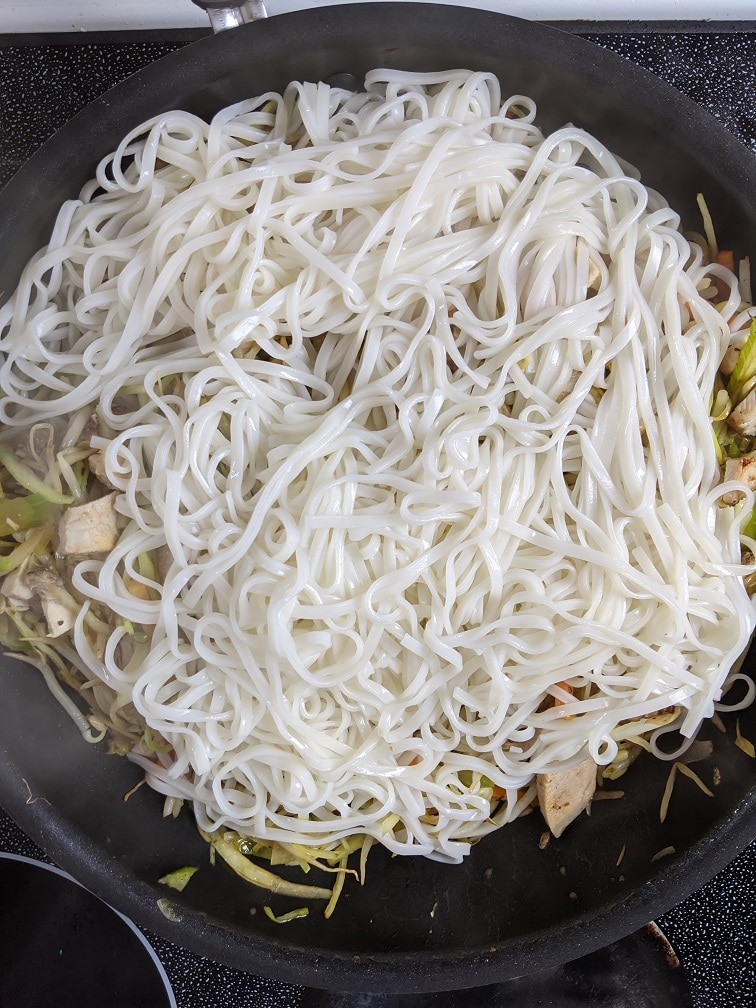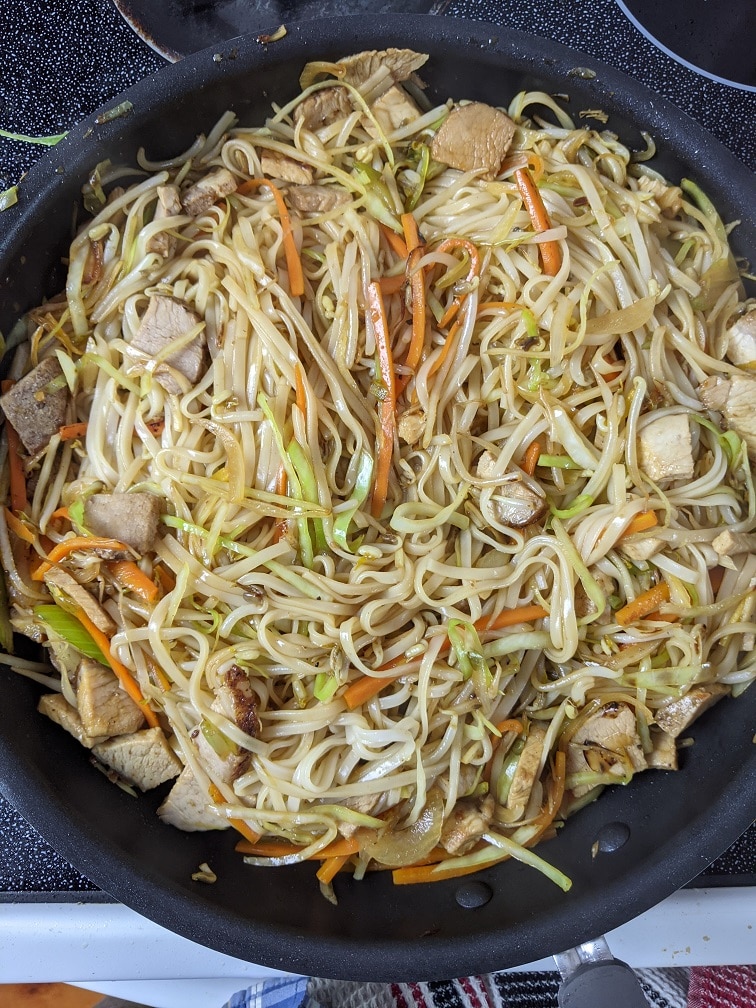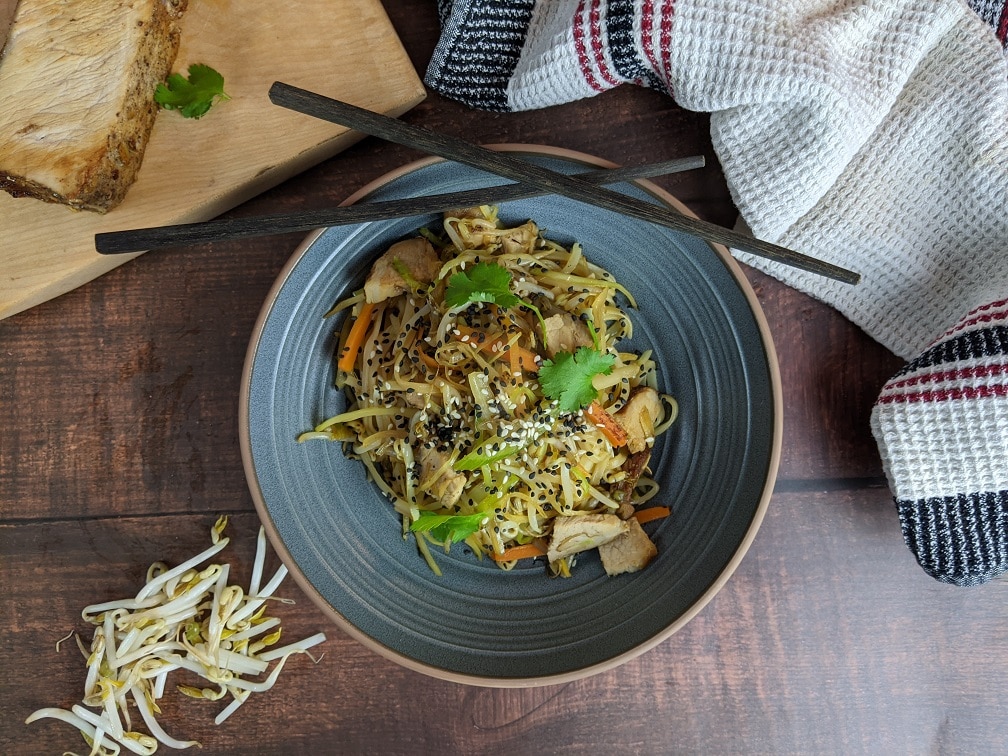Today we will be looking at how to make delicious BBQ Pork Chow Mein. If you love noodles stir-fried with vegetables and tender pieces of pork, then this is for you. Chow Mein is one of my favourite Chinese Take-Out dishes, and I am really excited to share this with you today. So, let's cut the gibber gabber and get cooking. Let's get to it.

The Pork
When making BBQ Pork Chow Mein, the most logical place to start is with the pork. That is exactly what we are going to do. Chinese BBQ pork is often bright red from the addition of either red bean paste or just straight-up red food colouring. I couldn't find red bean paste, and I had zero interest in dying my meat with food colouring so, it's not red. But it tastes amazing, so does it really matter?
Marinade
The pork's marinade is composed of Chinese Five Spice (find the recipe at the end of this post), brown sugar, crushed red pepper flakes, ginger, garlic, salt and soy sauce. You can find all of the measurements in the full recipe below. Traditionally, this marinade would have a small portion of wine or vinegar to add acidity, but I honestly didn't feel like the marinade needed it. You can add a tablespoon of rice vinegar if you'd like, but I'll leave that up to you.












The Pork
Typically, Chinese BBQ pork is made with chunks of shoulder meat. This is fattier and generally more flavorful than some other cuts of pork. However, I use pork loin for this recipe for two reasons. The first is that it is leaner and I know that it is more appealing to many people. The second reason is that I couldn't find anything but large roasts of pork shoulder, and I didn't want to have a tonne of extra meat. Oh, and it was super cheap. Of course, feel free to sub the pork loin for some shoulder meat. The pork loin I used was just over a pound and a half.

Marinating The Pork
As you can see from the pictures above, I made the marinade in a large ziplock bag. I like using ziplock bags to marinate meat because it takes up less space in the fridge, and you can use less marinated and have the meat completely covered. To marinate the meat, add it to the bag with the marinade, make sure it is fully covered, squeeze the excess air out of the bag, seal it and put it in the fridge overnight.




Roasting The Pork
The next day, take the pork out of the marinade and roast in a 350°F oven for 45 minutes to an hour or until a thermometer inserted into the pork reads 155°F. Let the pork rest for at least ten minutes, slice it into thirds lengthwise, and slice those thirds into thin pieces. For the chow mein, you need about one cup of sliced pork. The rest can be saved for fried rice, soup, or even sandwiches.



The Noodles
The noodles used for this dish would normally be a chewy wheat noodle like a ramen-style noodle. Because I can't eat gluten, those noodles are out of the question for me. However, if you can eat gluten, I suggest using those noodles instead of the rice noodles I'm using. The grocery store will have a few different kinds, and you'll have to figure out which noodle brand is right for you. You can find the noodles in either the international food section or the Asian food section.
I cooked the noodles in boiling water for 6 minutes as per the package instructions. It is essential that the noodles not be overcooked because they will fall apart in your stir-fry. If anything, undercook the noodles slightly. They are going to cook a bit more anyway. Once the noodles are cooked, drain the water and rinse the noodles under cold water until they are fully cooled. Let the noodles sit in a colander until you are ready to use them. Rice noodles tend to get very sticky as they sit, but a quick rinse under the tap will loosen them up again. So, rinse them really quickly right before you add them to the stir-fry. Just make sure to drain them well.




The Vegetables
The vegetables that I like to use in my chow mein are pretty standard. They are what you'll find in most take-out chow mein dishes. To start, there is some thinly sliced onion and celery. Then, some julienned carrots, followed by some thinly sliced cabbage and bean sprouts. To add a bit of flavour, I also used two cloves of garlic and a bit of ginger. You can find all of the measurements in the full recipe below. Additionally, you can add mushrooms, water chestnuts, baby corn, snap peas, or Chinese long beans.







The Sauce
Every stir-fry needs some kind of sauce, and this is no different. The sauce for this BBQ pork chow mein is a quarter cup of soy sauce mixed with one tablespoon of sugar and a quarter teaspoon of white pepper. That's it. You can substitute the white pepper for black pepper if you'd prefer.



Making BBQ Pork Chow Mein
To make the chow mein, first heat a large frying pan or wok over medium-high heat. The pan should be very hot before anything goes in it. First up, goes in a bit of oil. I used sesame oil, but you can use peanut, canola, sunflower, or whatever else you'd like. Next goes in the onion, celery, and carrot. Stir-fry these vegetables until the onions soften. That should take three to four minutes. Then goes in the ginger and garlic, which gets cooked for a minute or two.



As soon as you can really start to smell ginger and garlic, you can add the cabbage, bean sprouts and pork to the pan. Stir-fry until the cabbage starts to wilt a little, about four minutes. I like to let things sit in the pan for a minute and darken on the bottom slightly, but that is a personal preference. If you don't like a little colour on your vegetables, then keep them moving.




Once the cabbage is soft, you can toss in the noodles. Really toss them around to make sure they are mixed well with the vegetables. Add the sauce, toss everything together, and keep cooking until the noodles are hot.




Serve the BBQ Pork Chow Mein garnished with a few sesame seeds and cilantro leaves or thinly sliced green onion for colour. This can be served as a main course or as a side dish with General Tso Chicken or Sweet and Sour Chicken Balls.

Ingredients
BBQ Pork
- 1 ½ lb Pork Loin
- 1 tablespoon Chinese 5 Spice
- 1 tablespoon Brown Sugar
- ½ teaspoon Crushed Red Pepper Flakes
- 1 tablespoon Minced Ginger
- 1 tablespoon Minced Garlic
- ¼ teaspoon Salt
- ¼ cup Soy Sauce
Vegetables
- ½ cup Sliced Onion
- ½ cup Carrot, peeled, and cut into thin sticks
- 1 cup Celery, thinly sliced
- 1 cup Cabbage, thinly sliced
- ½ cup Onion, thinly sliced
- 1 tablespoon Garlic, peeled and thinly sliced
- 1 tablespoon Ginger, thinly sliced
- 2 cups Bean Sprouts, washed and drained
- 1 tablespoon Sesame Oil
- 150 g Dried Rice Noodles
Stir-Fry Sauce
- ¼ cup Soy Sacue
- 1 teaspoon Sugar
- ¼ teaspoon White Pepper
Instructions
Pork
- Put all of the marinade ingredients in a large ziplock bag except the pork.
- Mix well and add in the pork. Roll the pork in the marinade to coat the pork. Squeeze all the excess air out of the ziplock bag, roll and seal. Put the bag in the fridge overnight.
- Preheat the oven to 350°f.
- Take the pork out of the bag and put it in a small roasting pan. Roast the pork in the oven for 50 minutes or until the internal temperature reaches a temperautre of 150°f.
- Let the pork rest for at least 10 minutes then slice it lengthwise into thirds. Cut the thirds across the grain of the meat into 3-4 mm slices.
- Use one cup of the sliced pork for the noodles and save the rest to throw in a soup or fried rice.
The Noodles
- Bring a large pot of water to a boil.
- Add the noodles to the water and cook for six minutes (or based on the package instructions)
- Once the noodles are cooked, drain the water and rinse the noodles under cold water until cool.
The Stir-fry
- Heat a large frying pan or wok over medium-high heat. Add the sesame oil to the pan along with the onions, celery, and carrots. Cook, stirring every 30 seconds or so, until the onions start to soften, about three minutes.
- Add in the ginger and garlic and cook for a minute or two. Then add in the cabbage, bean sprouts, and pork. Cook, stirring every minute or so for 3-4 minutes then add in the noodles and the sauce.
- Toss all the ingredients together and cook until the noodles are hot.
- Serve the chow mein garnished with sesame seeds.
Conclusion
If there is anything better than noodles tossed with meat and vegetables, I don't know what it is, and I don't care too. I have fond memories of this dish from my youth working a summer job in a Chinese Take-Out restaurant and have eaten literal piles of these noodles. I am so happy to share this recipe with you, and I hope that you enjoy it as much as I do. Have a great day, everyone. I'll see you soon.
Thank you for reading the post. If you liked it, remember to share it on Facebook, Pinterest, or Twitter by clicking the icon to the left of the page. Did you know that Chefsnotes.com has almost 400 posts just like this one? Don’t ever miss a post again. Become a Chef’s Notes member right here. You will be notified of every new post. And if you would like to know more about me, click the link below to read my story.


Ingredients
- 4 Star anise
- 3 cloves
- 4 teaspoon Szechwan peppercorns
- 1 tablespoon fennel seeds
- ¼ cinnamon stick
Instructions
- Combine the spices in a spice grinder and grind to a powder.
- Store in an airtight container.





[…] Marinade. The pork’s marinade is composed of Chinese Five Spice (find the recipe at the end of this post), brown sugar, crushed red pepper flakes, ginger, garlic, salt and soy sauce. You can find all of Chefs Notes […]